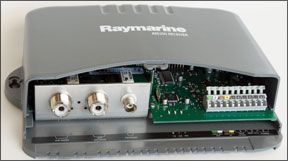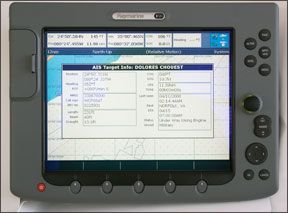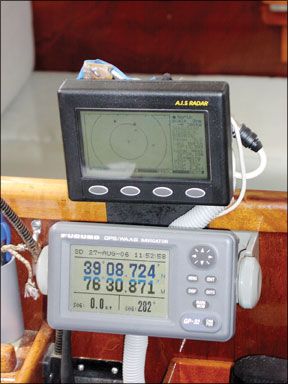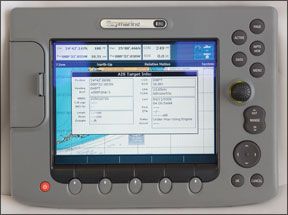Automatic Information System (AIS) devices have been required on large commercial ships since 2002. Their popularity is growing in the U.S. recreational sailboat market, thanks to the Federal Communications Commissions (FCC) recent approval of AIS Class B transponders. Some devices allow users to send and receive information about a ship-location, size, speed, call sign, and MMMI number. Others, like the Raymarine AIS 250, only receive AIS broadcasts from other AIS-equipped ships. The Raymarine AIS250 receives AIS Class A and AIS Class B broadcasts. Practical Sailor found that the device performed well, and was user-friendly and easy to install. But, for a receive-only unit, its pricey: $980, or about three times as much as similar devices on the market. If you already have a Raymarine network and prefer to see but not be seen, then the AIS250 is worth considering.
****

288
Any product that can help boats avoid collision is worth a look. As ship collision-avoidance technology like the Automatic Information System (AIS), which has been required on large commercial ships since 2002, makes headway in the recreational boating market, we will be putting relevant gear through its paces.
We last looked at AIS devices in the March 2007 issues Ocean Tested review of the Nasa Marine AIS Radar, an AIS receiver and small display private labeled by SI-TEX Marine. In this article, we review Raymarines AIS250, a listen-only device that does not come with a display.
Stay tuned for future tests of AIS transponders marketed to recreational boaters, a product field we expect to see grow in leaps and bounds on the heels of recent federal approval regarding their usage. (See “Market Watch,” page 21.)
AIS Basics
The Automatic Information System is similar in function to the mandatory collision-avoidance system carried on airliners. Simply put, every airliner in the sky talks to others using data streams that broadcast information about the aircraft position, speed, and altitude. If the system detects an imminent collision threat, it sounds an alarm. The marine version of this system, AIS, is far less sophisticated.
Starting in 2002, the International Maritime Organization (IMO)s International Convention for the Safety of Life at Sea (SOLAS) regulations required that all ships over 300 gross tons carry and operate at all times an AIS. The system uses two types of transponders, Class A and Class B, to transmit and receive via specific VHF channels a wide variety of static and dynamic information about a ship, including its name, latitude and longitude, course over ground, speed over ground, heading, status, and Maritime Mobile Service Identity (MMSI) number. The broadcasts happen every few seconds.

288
Ships required by the IMO to carry an AIS system must use a Class A transceiver. AIS-A has the highest level of information transmittal, a faster rate of information updating, and allows texting between equipped ships. AIS-A devices, intended for use on commercial ships, can be prohibitively expensive for the average cruiser.
Among the various IMO-compliant AIS-A systems on the market are Furunos FA150 ($4,500,
www.furunousa.com), Simrads A18 ($4,100, www.consumersmarine.com), and JRCs JHS-182 ($3,500, www.consumersmarine.com).Class B transponders are designed for use on smaller vessels not required to meet the IMOs AIS carriage rules. These units transmit fewer data fields at a slower rate than Class A units. For example, on a ship moving less than 14 knots, a Class A unit would be required to update all dynamic information like ships speed and heading every 10 seconds. A Class B transceiver is only required to update every 30 seconds.
AIS-B transponders are typically less expensive than Class A devices and draw less power. However, because their signals are weaker, ships transmitting AIS-B wont always be seen by those operating AIS-A. Furthering this problem, most AIS systems have screen de-cluttering features that allow users to ignore Class B signals and display only AIS-A transmissions.
There is a growing group of Class B devices available. One such device is the ACR Nauticast B transceiver system ($750,
www.ca.binnacle.com), which costs significantly less than Class A systems.In addition to Class A and B transponders, there are devices like the Raymarine AIS250 that can read AIS information but do not transmit any information. These receivers, often the least expensive of the AIS products, are appropriate for those who want the benefits of AIS without worrying about being monitored by Big Brother. Some are sold as display-receiver combos, others are black-box receivers that must be mated with a compatible PC or multifunction display, and others still work only with PCs.
The SI-TEX AIS Radar Receiver we previously reviewed comes with a 5-inch monochrome display and costs about $529 (
www.consumersmarine.com).Receiver-only products that can work with a PC or multifunction display include the Furuno FA30 ($722,
www.defender.com) and the SI-TEX AIS Black Box Receiver ($306, www.defender.com).PC-only compatible receivers include the single-band Smart Radio SR161 ($189,
www.milltechmarine.com) and another SI-TEX AIS black box ($289, www.defender.com), which we used for our navigation software tests for the September 2006 issue.Raymarine AIS250
The listen-only Raymarine AIS250 monitors both Class A and Class B AIS

288
broadcasts. It is designed to work with a C-, G-, or E-series Raymarine multifunction display, overlaying the AIS information in chartplotter or radar modes. It also can interface with PCs and some non-Raymarine chartplotters and multifunction displays, as long as theyre NMEA 0183 and AIS compatible.
The AIS250 measures 8.6 by 6.7 by 2.5 inches and weighs just under 20 ounces. Designed for bulkhead mounting, it must be placed in a protected area-a nav station or enclosed pilot house-as its not designed to withstand spray or splashing.
The AIS250 needs a 12-volt DC power supply, a VHF antenna, and a compatible display. It comes with a VHF input and VHF output jack. This allows the user to connect the AIS250 to an existing VHF antenna and, using a supplied cable, hook back up to the VHF radio. However, this puts the AIS250 between your VHF antenna and VHF radio, which could affect the performance of the VHF or receiver, according to Raymarine. Another option would be installing a dedicated VHF antenna.
The AIS250 is a dual-multiplexed, single-band receiver. It can only monitor one of the two designated AIS frequencies at a time, but it automatically switches between the two at a high speed. Single-channel devices are limited in that messages from a vessel transmitting every six minutes-like the vessel name and call sign-and alternating between channels, would only be received every 12 minutes. Dual-band receivers monitor both frequencies simultaneously and offer faster info updates.
Field Run
To test the Raymarine AIS250 for functionality, we mounted it on our powerboat test boat. Using the built-in splitter, we connected it to our VHF radio antenna, and then connected it to a Raymarine E120 multifunction display, which edged past the Garmin 5212 display in our August 2008 review. Despite Raymarines warnings that this setup could affect VHF performance, testers did not notice any obvious AIS or VHF signal or range degradation.

288
We connected the E-series display to the high-speed NMEA jacks on the AIS250. Lower-speed NMEA jacks are also supplied for use with some non-Raymarine displays.
The AIS250 draws very little power: 200 milliamps. The E120 multifunction display draws about 2.7 amps at max brightness.
Once the AIS250 was installed, we went to sea to test how well it received broadcasts from ships offshore of our Florida Keys test location.
Testers set the AIS250 to display the target ships information in the chartplotter mode. The information for several ships was displayed simultaneously and was easy to read. Information on a particular ship can be viewed by placing the cursor over the target. This brings up a box listing a variety of information on the ship. Ships broadcasting with AIS-B systems will not have as much information displayed as those broadcasting AIS-A. According to Raymarine, the AIS250 can display up to 100 AIS-broadcasting ships. Its range will vary, depending on your VHF antenna and its location.
Users can select the safety zone distance around the boat, adjusting it to a variety of distances based on time or mileage. Should a passing ship enter the safety zone, auditory and visual alarms will be sounded on the AIS250, alerting the helmsman to act to avoid collision.
We found the Raymarine AIS250 receiver for $980 (
www.defender.com). It carries a two-year warranty. To add the E120 multifunction display network would cost another $3,900 (www.consumersmarine.com).The Bottom Line
AIS is a useful navigation aid, but it by no means is a substitute for watchkeeping or radar. Radar tracks vessels regardless of whether they are equipped with any form of electronic aid to navigation. AIS will not “see” rocks, reefs, or other natural hazards-only an alert watchman will see those. That being said, AIS offers added security, especially in extreme weather, shipping lanes, and other areas where collision risks are high.
The Raymarine AIS250 performed well, and was user-friendly and easy to install. But, for a receive-only device, its pricey. SI-TEXs comparable receiver costs one-third of the AIS250, and some Class B transponders are priced lower. If you already have a Raymarine network and prefer to see but not be seen, then the AIS250 is worth considering.
Otherwise, we recommend holding off on purchasing any AIS equipment. In the wake of the Federal Communications Commissions AIS-B approval (see “Market Watch,” above), were likely to see receiver prices drop as new, more affordable Class B transponders hit the market.



































